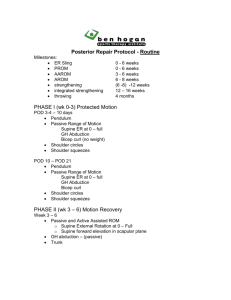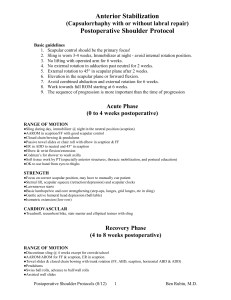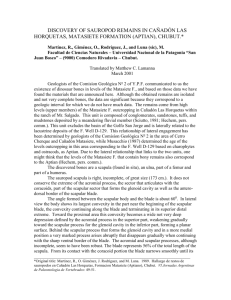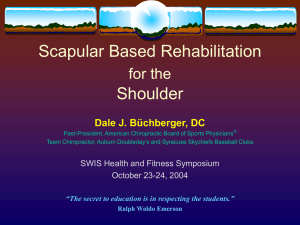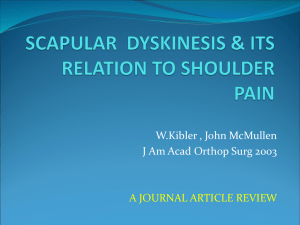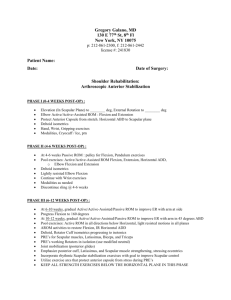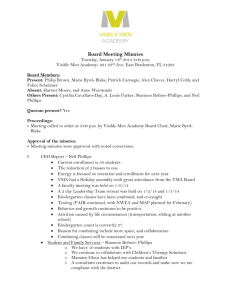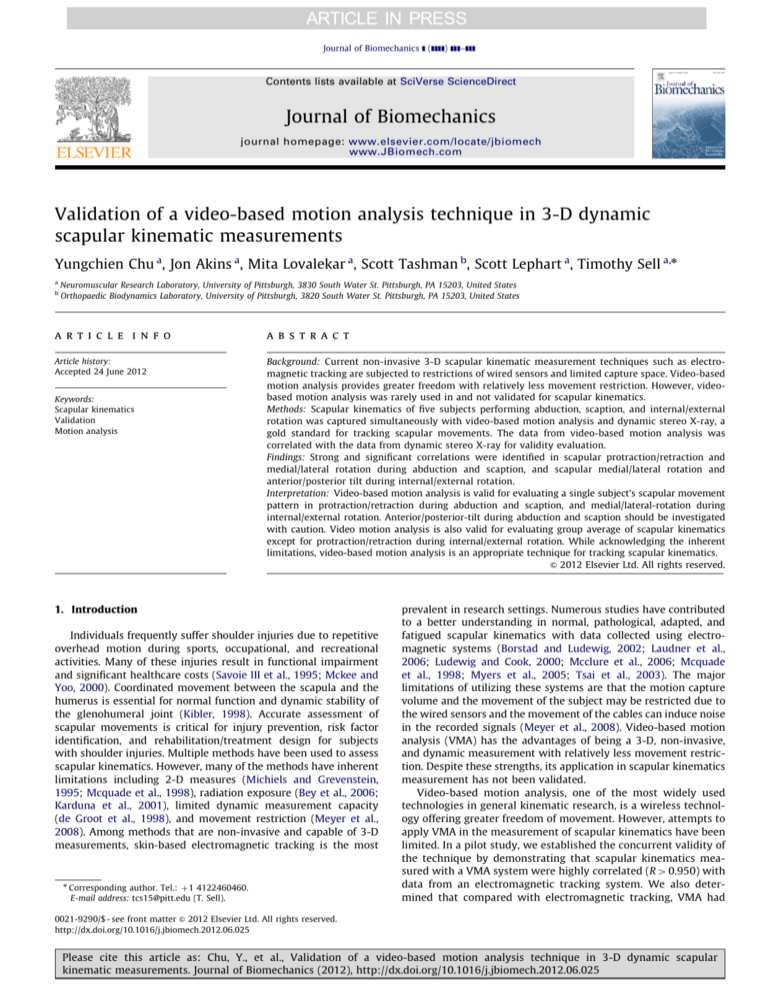
Journal of Biomechanics ] (]]]]) ]]]–]]]
Contents lists available at SciVerse ScienceDirect
Journal of Biomechanics
journal homepage: www.elsevier.com/locate/jbiomech
www.JBiomech.com
Validation of a video-based motion analysis technique in 3-D dynamic
scapular kinematic measurements
Yungchien Chu a, Jon Akins a, Mita Lovalekar a, Scott Tashman b, Scott Lephart a, Timothy Sell a,n
a
b
Neuromuscular Research Laboratory, University of Pittsburgh, 3830 South Water St. Pittsburgh, PA 15203, United States
Orthopaedic Biodynamics Laboratory, University of Pittsburgh, 3820 South Water St. Pittsburgh, PA 15203, United States
a r t i c l e i n f o
abstract
Article history:
Accepted 24 June 2012
Background: Current non-invasive 3-D scapular kinematic measurement techniques such as electromagnetic tracking are subjected to restrictions of wired sensors and limited capture space. Video-based
motion analysis provides greater freedom with relatively less movement restriction. However, videobased motion analysis was rarely used in and not validated for scapular kinematics.
Methods: Scapular kinematics of five subjects performing abduction, scaption, and internal/external
rotation was captured simultaneously with video-based motion analysis and dynamic stereo X-ray, a
gold standard for tracking scapular movements. The data from video-based motion analysis was
correlated with the data from dynamic stereo X-ray for validity evaluation.
Findings: Strong and significant correlations were identified in scapular protraction/retraction and
medial/lateral rotation during abduction and scaption, and scapular medial/lateral rotation and
anterior/posterior tilt during internal/external rotation.
Interpretation: Video-based motion analysis is valid for evaluating a single subject’s scapular movement
pattern in protraction/retraction during abduction and scaption, and medial/lateral-rotation during
internal/external rotation. Anterior/posterior-tilt during abduction and scaption should be investigated
with caution. Video motion analysis is also valid for evaluating group average of scapular kinematics
except for protraction/retraction during internal/external rotation. While acknowledging the inherent
limitations, video-based motion analysis is an appropriate technique for tracking scapular kinematics.
& 2012 Elsevier Ltd. All rights reserved.
Keywords:
Scapular kinematics
Validation
Motion analysis
1. Introduction
Individuals frequently suffer shoulder injuries due to repetitive
overhead motion during sports, occupational, and recreational
activities. Many of these injuries result in functional impairment
and significant healthcare costs (Savoie III et al., 1995; Mckee and
Yoo, 2000). Coordinated movement between the scapula and the
humerus is essential for normal function and dynamic stability of
the glenohumeral joint (Kibler, 1998). Accurate assessment of
scapular movements is critical for injury prevention, risk factor
identification, and rehabilitation/treatment design for subjects
with shoulder injuries. Multiple methods have been used to assess
scapular kinematics. However, many of the methods have inherent
limitations including 2-D measures (Michiels and Grevenstein,
1995; Mcquade et al., 1998), radiation exposure (Bey et al., 2006;
Karduna et al., 2001), limited dynamic measurement capacity
(de Groot et al., 1998), and movement restriction (Meyer et al.,
2008). Among methods that are non-invasive and capable of 3-D
measurements, skin-based electromagnetic tracking is the most
n
Corresponding author. Tel.: þ1 4122460460.
E-mail address: tcs15@pitt.edu (T. Sell).
prevalent in research settings. Numerous studies have contributed
to a better understanding in normal, pathological, adapted, and
fatigued scapular kinematics with data collected using electromagnetic systems (Borstad and Ludewig, 2002; Laudner et al.,
2006; Ludewig and Cook, 2000; Mcclure et al., 2006; Mcquade
et al., 1998; Myers et al., 2005; Tsai et al., 2003). The major
limitations of utilizing these systems are that the motion capture
volume and the movement of the subject may be restricted due to
the wired sensors and the movement of the cables can induce noise
in the recorded signals (Meyer et al., 2008). Video-based motion
analysis (VMA) has the advantages of being a 3-D, non-invasive,
and dynamic measurement with relatively less movement restriction. Despite these strengths, its application in scapular kinematics
measurement has not been validated.
Video-based motion analysis, one of the most widely used
technologies in general kinematic research, is a wireless technology offering greater freedom of movement. However, attempts to
apply VMA in the measurement of scapular kinematics have been
limited. In a pilot study, we established the concurrent validity of
the technique by demonstrating that scapular kinematics measured with a VMA system were highly correlated (R40.950) with
data from an electromagnetic tracking system. We also determined that compared with electromagnetic tracking, VMA had
0021-9290/$ - see front matter & 2012 Elsevier Ltd. All rights reserved.
http://dx.doi.org/10.1016/j.jbiomech.2012.06.025
Please cite this article as: Chu, Y., et al., Validation of a video-based motion analysis technique in 3-D dynamic scapular
kinematic measurements. Journal of Biomechanics (2012), http://dx.doi.org/10.1016/j.jbiomech.2012.06.025
2
Y. Chu et al. / Journal of Biomechanics ] (]]]]) ]]]–]]]
similar inter-trial reliability (ICC 0.947 vs. 0.937) and significantly
better precision (SEM 0.94 vs. 1.23, po0.001) in scapular
kinematic measurements. Despite these findings, this scapular
kinematic measurement technique using VMA has not been
validated against a gold standard.
With the improvement of hardware capacity, we believe that
VMA can now realize its potential in assessing scapular movement. Therefore, the purpose of the current study was to validate
the VMA scapular kinematic measurement technique against
a gold standard, Dynamic stereo X-ray (DSX), which can provide
direct, high-accuracy measurements of bone motion. We
hypothesized that high correlations (R40.70) in the scapular
kinematic patterns would exist between the VMA and DSX data.
If validated and with the high prevalence of VMA systems in
biomechanical laboratories, more researches can be conducted,
stimulating research variability and quantity.
2. Methods
2.3. Procedures
Subjects underwent a CT scan for the scapula and humerus on their dominant
arms. Images were collected with a slice thickness of 1.25 mm using a LightSpeed16 System (GE Healthcare, Waukesha, WI, USA). The CT images were
reconstructed into 3-D computer bone models of scapula and humerus using
Mimics software (Materialise Medical Software, Leuven, Belgium). Local coordinate systems (LCS) for the humerus and scapula were defined using anatomical
landmarks listed in Table 1.
Reflective markers with a diameter of 9 mm were attached to anatomical
landmarks on each subject’s trunk, humeri, and scapulae (Table 1). Two custommade triads, each with three reflective markers, were attached to the flat, broad
portion of the acromial process, bilaterally. The triads were triangular in shape
with a reflective marker on each corner, approximately 3 cm apart. For each
subject, a static capture of the markers was made using the VMA system with the
subject in the standard anatomical position. After the static capture, the acromial
angle, root of the scapular spine, and inferior angle markers were removed.
Subjects performed abduction (arm elevation in the frontal plane), scaption
(arm elevation in the scapular plane), and an internal/external rotation task at 901
abduction. Movements were guided by a metronome at a frequency of 0.5 Hz.
Once the subjects were on pace with the metronome and the movements were
performed smoothly, the researcher would trigger the DSX and VMA systems to
capture a one-repetition trial.
2.1. Subjects
2.4. Data reduction
Five right handed, healthy, and physically active male subjects (age ¼
27.8 76.9 yr; Ht¼ 181.0 74.9 cm; Wt ¼77.9 7 9.5 kg) volunteered to participate
in this study. All subjects had no history of musculoskeletal injury to the upper
extremity within 3 months before their participation and no history of any upper
extremity joint reconstructive surgery. All subjects provided informed consent in
accordance with the University’s Institutional Review Board.
2.2. Instrumentation
In this study, the DSX model-matching technique, a gold standard for
measuring scapular kinematics (Bey et al., 2006), was used to validate the VMA
technique. The DSX system (Fig. 1) included two 100 kW pulsed X-ray generators
(EMD Technologies, Quebec, Canada), two 40 cm image intensifiers (Thales,
Neuilly-sur-Seine, France), and two high-speed video cameras (Vision Research,
Wayne, NJ, USA) that were synchronized together. The system was configured
with an inter-beam angle of approximately 601. Both beams were aimed at the
dominant shoulder of the subject to capture X-ray images of the scapula and
humeral head. The distance between the X-ray sources and the subject was
approximately 100 cm and the distance between the subject and the image
intensifiers was about 50 cm. In this study, the system was set to capture at
50 Hz using a pulsed protocol (2 ms pulses, 70kVp, up to 160 mA). Total radiation
exposure from DSX testing was less than 7 mGy. A Vicon Nexus motion capture
system with eight high-speed cameras (Vicon, Oxford, UK) was used for VMA. The
VMA system was also set at 50 Hz and synchronized with the DSX system using a
trigger allowing for simultaneous data collection.
3D kinematics of the scapula and humerus were determined from the DSX
image sequences using a previously described and validated model-based tracking
technique (Bey et al., 2006). Briefly, a 3-D volumetric bone model was derived
from CT. A virtual model of the DSX system geometry was created for generating a
pair of digitally reconstructed radiographs (DRR’s) via ray-traced projection
through the CT bone model. The bone model was automatically repositioned
within the virtual model until the best match was achieved between the
simulated DRR’s and the actual radiographic image pair. Once the positions of
the humerus and scapula were determined for each motion frame, the positions of
all the anatomical landmarks previously defined in bone LCSs were transformed
into the global coordinate system (GCS) of the DSX and exported by custom
software. For the VMA data, the 3-D positions of markers were reconstructed in
the GCS of the VMA. The position of the humeral head was estimated on the
anthropometric data using the Plug-in Gait Model (Vicon, Oxford, UK). The 3-D
coordinates of the markers were exported by the Vicon Nexus software.
The VMA and DSX data were loaded into a custom Matlab program (Mathworks,
Natick, MA) for further processing. Data were filtered using a fourth order zero-lag
low-pass Butterworth filter with a cutoff frequency set at 5 Hz, as determined with
power spectrum analysis. For each trial, the local coordinate system (LCS) of the
thorax was defined using the VMA data, as it was not modeled with the DSX. The
LCSs of the humerus and scapula were defined for both VMA and DSX data. Humeral
and scapular movements were calculated as the humerus and scapula LCSs with
respect to the thorax LCS. The scapular movement was decomposed into three
Table 1
Anatomical landmarks used in this study and their data source.
Body segment
Humerus
Anatomical
landmarks
Humeral head
Medial epicondyle
Lateral epicondyle
Fig. 1. Equipment setting during data collection.
Source of data
VMA
DSX
Virtual positions
estimated based on
surface markers
and anthropometric
data
Surface marker
positions
Positions
marked in 3-D
computer
bone model
Scapula
Acromioclavicular
joint
Acromial angle
Root of the spine
of scapula
Inferior angle
Surface marker
positions
Virtual positions
estimated based on
surface markers in
the static capture
and triad markers
Positions
marked in 3-D
computer
bone model
Thorax
C7
T10
Jugular notch
Xiphoid process
Surface marker
positions
(Use VMA
data)
Please cite this article as: Chu, Y., et al., Validation of a video-based motion analysis technique in 3-D dynamic scapular
kinematic measurements. Journal of Biomechanics (2012), http://dx.doi.org/10.1016/j.jbiomech.2012.06.025
Y. Chu et al. / Journal of Biomechanics ] (]]]]) ]]]–]]]
components in Euler sequence: protraction/retraction, medial/lateral-rotation, and
anterior/posterior-tilt; the humeral movement was decomposed into elevation plane,
elevation, and internal/external rotation. All the LCSs and movement components
were defined following the ISB recommendations (Wu et al., 2005).
2.5. Statistical analyses
The validity of the VMA against the DSX was evaluated on both the individual
and group level for different application purposes. If validated at the individual
level, the VMA can be used to record the scapular movement of a single subject
and identify potential pattern abnormality. If validated at the group level, the VMA
can be used for group comparisons to identify the potential kinematic differences
between a healthy and a pathological group.
At the individual level, Pearson’s correlation coefficient was calculated and
averaged across subjects. Alpha was set at 0.05 for correlation analysis. The range
of motion (ROM) for the humerus (the major component of movement only) and
scapula were calculated for both the DSX and VMA data. Paired t-tests were used
to compare the humeral and scapular ROM measured with the DSX and VMA, with
alpha set at 0.05.
To make comparisons possible at the group level, data were extracted for every 101
increment from 301 to 1401 of arm elevation for the abduction and scaption tasks, and
from 301 arm internal rotation to 401 external rotation for the internal/external rotation
task. Pearson’s correlation coefficient was calculated between the DSX and VMA
scapular data using the group averages at these data points, with alpha set at 0.05. The
correlations were calculated for the full movement, and movements of different
humeral movement directions. To evaluate the accuracy of the VMA technique, errors
were also evaluated for every 101 increment of humeral angle within the stated range
of motion of each task. For a given humeral angle, the root mean square of the
difference between the scapular orientations measured by the DSX and VMA was
calculated, and then averaged across subjects.
3
orientation (all p o0.01). For the scaption task, a weak and
insignificant relationship was found in one subject’s scapular
anterior/posterior-tilt (R¼ 0.120, p ¼0.246). For the internal/
external rotation task, a weak and insignificant relationship was
found in two subjects’ scapular protraction/retraction (R¼
0.130, p¼ 0.198 and R¼0.080, p ¼0.425, respectively). Humeral
and scapular range of motion is presented in Table 3. The ROM of
the DSX measurements were significantly greater in scapular
medial/lateral-rotation for both the abduction and scaption task
(p ¼0.001 and 0.002, respectively), and in anterior/posterior-tilt
for the internal/external rotation tasks (p¼0.03). The root mean
square errors are presented in Table 4.
Table 4
Root mean square errors of the scapular kinematic measurements.
Task
Humerus
movement
Abduction Humerus
raising
Humerus
lowering
Both
Scaption
Humerus
raising
Humerus
lowering
Both
IR/ER
Humerus
rotating in
Humerus
rotating out
Both
3. Results
Results of the individual level analyses are presented in
Table 2. For the abduction task, the DSX and VMA data were
strongly correlated for all the three components of scapular
Pro/retraction Med/lat
(deg.)
rotation (deg.)
Ant/posterior
tilt (deg.)
3.7
4.6
5.3
3.8
9.2
5.3
3.8
6.2
6.9
4.5
5.3
7.0
4.3
5.9
4.9
5.2
5.9
5.2
14.2
6.0
6.7
6.2
10.8
6.4
6.0
12.5
6.6
Table 2
Pearsons’ R of scapular orientations.
Task
Analysis level
Variable
Scapular orientation components
Pro/retraction
Med/lat rotation
Ant/posterior tilt
Abduction
Individual
group
Pearson’s
Pearson’s
Pearson’s
Pearson’s
R
R humerus raising
R humerus lowering
R both
0.913(0.093)
0.981
0.963
0.901
0.967(0.032)
0.985
0.999
0.902
0.573(0.698)
0.997
0.994
0.986
Scaption
Individual
group
Pearson’s
Pearson’s
Pearson’s
Pearson’s
R
R humerus raising
R humerus lowering
R both
0.802(0.093)
0.833
0.957
0.885
0.969(0.023)
0.992
0.998
0.947
0.705(0.470)
0.937
0.965
0.946
IR/ER
Individual
group
Pearson’s
Pearson’s
Pearson’s
Pearson’s
R
R humerus rotating in
R humerus rotating out
R both
0.412(0.433)
0.157a
0.967
0.141b
0.935(0.047)
0.998
0.992
0.849
0.887(0.096)
0.995
0.997
0.748
a
b
Insignificant correlation (p¼ 0.717).
Insignificant correlation (p ¼0.606).
Table 3
Range of motion (ROM) of the humerus and scapula during different tasks.
Task
Humeral ROM (of the primary
component of movement)
Scapular ROM
Pro/retraction
VMA
Abduction (deg.)
Scaption (deg.)
IR/ER (deg.)
n
128.6(11.2) (elevation)
121.7(7.5) (elevation)
111.3(23.3) (IR/ER)
12.7(7.4)
10.9(6.2)
9.2(2.5)
Med/lat rotation
DSX
10.6(1.6)
12.0(5.9)
7.1(1.5)
VMA
Ant/posterior tilt
DSX
n
31.2(3.4)
34.4(5.4)n
12.9(7.7)
n
45.7(2.1)
48.5(5.5)n
14.9(10.5)
VMA
DSX
14.1(4.2)
13.9(4.6)
11.5(6.5)n
14.7(7.2)
14.0(3.9)
14.8(8.3)n
Significant difference between the DSX and VMA measurements (paired t-test p o 0.05).
Please cite this article as: Chu, Y., et al., Validation of a video-based motion analysis technique in 3-D dynamic scapular
kinematic measurements. Journal of Biomechanics (2012), http://dx.doi.org/10.1016/j.jbiomech.2012.06.025
4
Y. Chu et al. / Journal of Biomechanics ] (]]]]) ]]]–]]]
At the group level, Pearson’s correlation coefficients were
calculated separately with the different directions of movement
taken into consideration (Table 2). For both the abduction and
scaption task, strong and significant linear relationships in all
three scapular orientation components were detected (p o0.001).
For the internal/external rotation task, the linear relationship in
protraction/retraction was weak and not significant. The linear
relationships were strong and significant for the other two
components (po0.001)
4. Discussion
Video-based motion analysis is widely used in general biomechanical studies but less in scapular kinematic research. The
purpose of this study was to validate the application of VMA in
scapular kinematics. The hypothesis of high correlation between
the VMA and DSX data was supported except for anterior/posterior
tilt of the scapula during abduction and for scapular protraction/
retraction during internal/external rotation. We concluded that,
with some limitations acknowledged, VMA is a valid technique to
quantify scapular kinematics for clinical and research purposes.
With the prevalence and versatility of VMA, this technique has the
potential to expand the field of scapular kinematic research.
For clinical applications, the VMA technique must be capable
of capturing the true movement pattern and orientation of the
scapula on a single subject, so one can determine whether an
observed pattern or scapular angle is pathological. In such cases,
a high correlation and comparable range of motion (ROM)
between the VMA and DSX data might be expected. For abduction
and scaption, the correlation was high for both protraction/
retraction and medial/lateral-rotation. The correlation of anterior/posterior-tilt was high for four of the five subjects, but the
weak correlation in one subject negatively affected the mean
values. This subject was very muscular and the poor agreement
was likely due to a greater amount of soft tissue effect. Caution
should be used when VMA is utilized to evaluate a single subject’s
scapular anterior/posterior-tilt pattern during arm elevation
when the subject is muscular. For internal/external rotation, the
correlation was high for both scapular medial/lateral-rotation and
anterior/posterior-tilt. The correlation was only moderate for
protraction/retraction, and not significant in two of the five
subjects. It may be inappropriate to evaluate a single subject’s
scapular protraction/retraction pattern during internal/external
rotation using VMA.
A high correlation is not enough to guarantee high pattern
agreement. Two sets of data can correlate perfectly when the
patterns change together, but may have different amplitudes and
slopes. The medial/lateral-rotation ROM during abduction and
scaption was significantly underestimated by approximately 141.
Similarly, Meskers et al. 2007 found that skin-based electromagnetic tracking underestimated the scapular lateral rotation by 131.
Such underestimation was most likely due to soft tissue effects.
Soft tissue effects might increase the difference between DSX and
VMA as arm elevation angle increased, as was observed in a
previous validation study using an electromagnetic tracking
device (Karduna et al., 2001). In Karduna et al. (2001), the
underestimation of scapular lateral rotation was 251, likely due
to a greater humeral range of motion (up to 1501 humeral
elevation, compared to 1401 in the current study). Considering
the high correlations, VMA is valid for evaluating scapular medial/
lateral rotation acknowledging the measurements are underestimated. The high correlation also indicated that soft tissue effects
may be corrected with regression (Van Der Helm, 1997).
For group level analysis, correlations were high except for
protraction/retraction during internal/external rotation, indicating
the inappropriateness of using VMA for this specific assessment.
For all other measures, high similarity between VMA and DSX data
was observed (Fig. 2). Similar to Karduna et al., (2001), the error
steadily increased with arm elevation angle. However, unlike
Karduna et al., we did not find dramatically increased error in
protraction/retraction and anterior/posterior tilt beyond 1201 of
arm elevation, suggesting the validity of these two measurements
through 1401. The scapular movement patterns appeared more
Fig. 2. Group average of scapular kinematics (solid line: VMA; dashed line: DSX; error bars: standard deviations across subjects).
Please cite this article as: Chu, Y., et al., Validation of a video-based motion analysis technique in 3-D dynamic scapular
kinematic measurements. Journal of Biomechanics (2012), http://dx.doi.org/10.1016/j.jbiomech.2012.06.025
Y. Chu et al. / Journal of Biomechanics ] (]]]]) ]]]–]]]
linear when utilizing the group average, consistent to the previous
radiography findings: the variability of scapulohumeral rhythm
across different phases decreased when calculated based on group
average scapular and humeral orientations, compared with calculating the average scapulohumeral rhythm of a group (Freedman
and Munro, 1966). Correlations were typically higher when different arm movement directions were evaluated separately. The
effects of arm movement direction on scapular kinematics have
been studied using bone-pin (Mcclure et al., 2001), palpation and
digitizing (Borstad and Ludewig, 2002; de Groot, Brand, 2001), and
skin-based electromagnetic tracking (Fayad et al., 2006).
Knowing that the VMA data at the group level replicated the
DSX data well enables researchers to use this technique to compare
scapular kinematic patterns among groups. Group comparisons
have been used to identify the scapular kinematic differences
between healthy people and impingement subjects (Mcclure
et al., 2006; Ludewig and Cook, 2000) or overhead athletes
(Laudner et al., 2006). So far there are no conclusive criteria to
classify a subject into a normal or pathological group, as the line
separating normal scapular kinematics and scapular dyskinesis is
yet to be established (Kibler et al., 2009). The use of the VMA
technique may expand the base of knowledge and result in the
accumulation of more data to establish the classification criteria.
The accuracy of the VMA technique was evaluated by calculating the root mean square errors over the entire range of motion
(Table 4). The calculated errors were within a range comparable to
the errors of the electromagnetic tracking technique, as presented
by Karduna et al. (2001). The current results showed that the
accuracy was higher during humerus raising than lowering in the
abduction and scaption tasks, and higher during humerus rotating
out than rotating in the IR/ER task. In Karduna et al. (2001), only
the data during humeral raising and rotating out were analyzed.
Several limitations of the VMA technique need to be
addressed. First, to minimize the radiation exposure to the
subjects, only one trial of data for each arm movement was
collected. As a result, a comprehensive error evaluation that
involves inter-trial analysis could not be conducted. Second, in
the current study, data were collected with five healthy and
physically active male subjects, which may lead to questioning
the generality of the results. Previous validation studies have used
similar sample sizes (Karduna et al., 2001; Meskers et al., 2007).
We believe that with the high pattern of correlation observed, five
subjects are sufficient for the research purpose. Although female
subjects were not recruited for this study, previous validation
studies have not reported a gender effect (Karduna et al., 2001;
Meskers et al., 2007). As we did not expect that the soft tissue
effects over the acromion differ in females, recruiting only male
subjects was sufficient for our purpose. Finally, muscle and
subcutaneous fat thickness were not measured over the acromion. We found that scapular anterior/posterior tilt measurement
during arm elevation was not valid for a muscular subject.
Increased subcutaneous fat may have similar or different effects.
Further research of larger sample size is needed to evaluate the
effects of muscle and/or fat and to investigate whether such
effects can be corrected.
In summary, VMA can be used for evaluating a single subject’s
scapular movement pattern in protraction/retraction during
abduction and scaption, and medial/lateral-rotation during internal/external rotation. Anterior/posterior-tilt during abduction and
scaption should be investigated with caution by confirming
whether the movement direction agrees with previous research.
Video-based motion analysis is also valid for evaluating group
average of scapular kinematics except for protraction/retraction
during internal/external rotation. While acknowledging the inherent limitations, VMA is an appropriate technique for tracking
scapular kinematics.
5
Conflict of interest statement
None
Acknowledgment
This study is funded by the Central Research Development
Fund, University of Pittsburgh.
References
Bey, M.J., Zauel, R., Brock, S.K., Tashman, S., 2006. Validation of a new model-based
tracking technique for measuring three-dimensional, in vivo glenohumeral
joint kinematics. Journal of Biomechanical Engineering 128, 604–609.
Borstad, J.D., Ludewig, P.M., 2002. Comparison of scapular kinematics between
elevation and lowering of the arm in the scapular plane. Clinical Biomechanics
17, 650–659.
De Groot, J.H., Brand, R., 2001. A three-dimensional regression model of the
shoulder rhythm. Clinical Biomechanics 16, 735–743.
De Groot, J.H., Valstar, E.R., Arwert, H.J., 1998. Velocity effects on the scapulohumeral rhythm. Clinical Biomechanics 13, 593–602.
Fayad, F., Hoffmann, G., Hanneton, S., Yazbeck, C., Lefevre-Colau, M.M., Poiraudeau, S.,
et al., 2006. 3-D scapular kinematics during arm elevation: effect of motion
velocity. Clinical Biomechanics 21, 932–941.
Freedman, L., Munro, R.R., 1966. Abduction of the arm in the scapular plane:
scapular and glenohumeral movement—a roentgenographic study. Journal of
Bone and Joint Surgery-A 48, 1503–1510.
Karduna, A.R., Mcclure, P.W., Michener, L.A., Sennett, B., 2001. Dynamic measurements of three-dimensional scapular kinematics: a validation study. Journal of
Biomechanical Engineering 123, 184–190.
Kibler, W.B., 1998. The role of the scapula in athletic shoulder function. American
Journal of Sports Medicine 26, 325–337.
Kibler, W.B., Ludewig, P.M., Mcclure, P., Uhl, T.L. & Sciascia, A., 2009. Scapular
Summit 2009: introduction. Journal of Orthopaedic and Sports Physical
Therapy39, A1-A13.
Laudner, K.G., Myers, J.B., Pasquale, M.R., Bradley, J.P., Lephart, S.M., 2006. Scapular
dysfunction in throwers with pathologic internal impingement. Journal of
Orthopaedic and Sports Physical Therapy 36, 485–494.
Ludewig, P.M., Cook, T.M., 2000. Alterations in shoulder kinematics and associated
muscle activity in people with symptoms of shoulder impingement. Physical
Therapy 80, 276–291.
Mcclure, P.W., Michener, L.A., Karduna, A.R., 2006. Shoulder function and
3-dimensional scapular kinematics in people with and without shoulder
impingement syndrome. Physical Therapy 86, 1075–1090.
Mcclure, P.W., Michener, L.A., Sennett, B.J., Karduna, A.R., 2001. Direct 3-dimensional measurement of scapular kinematics during dynamic movements
in vivo. Journal of Shoulder and Elbow Surgery 10, 269–277.
Mckee, M.D., Yoo, D.J., 2000. The effect of surgery for rotator cuff disease on
general health status. Results of a prospective trial. Journal of Bone and Joint
Surgery-A 82, 970–979.
Mcquade, K.J., Dawson, J., SMIDT, G.L., 1998. Scapulaothoracic muscle fatigue
associated with alterations in scapulohumeral rhythm kinematics during
maximum resistive shoulder elevation. Journal of Orthopaedic and Sports
Physical Therapy 28, 74–80.
Meskers, C.G.M., Van De Sande, M.A.J., De Groot, J.H., 2007. Comparison between
tripod and skin-fixed recording of scapular motion. Journal of Biomechanics
40, 941–946.
Meyer, K.E., Saether, E.E., Soiney, E.K., Shebeck, M.S., Paddock, K.L., Ludewig, P.M.,
2008. Three dimensional scapular kinematics during the throwing motion.
Journal of Applied Biomechanics 24, 24–34.
Michiels, I., Grevenstein, J., 1995. Kinematics of shoulder abduction in the scapular
plane: on the influence of abduction velocity and external load. Clinical
Biomechanics 10, 137–143.
Myers, J.B., Laudner, K.G., Pasquale, M.R., Bradley, J.P., Lephart, S.M., 2005. Scapular
position and orientation in throwing athletes. American Journal of Sports
Medicine 33, 263–271.
Savoie III, F.H., Field, L.D., Jenkins, R.N., 1995. Costs analysis of successful rotator
cuff repair surgery: an outcome study. Comparison of gatekeeper system in
surgical patients. Arthroscopy 11, 672–676.
Tsai, N.-T., Mcclure, P.W., Karduna, A.R., 2003. Effects of muscle fatigue
on 3-dimensional scapular kinematics. Archives of Physical Medicine and
Rehabilitation 84, 1000–1005.
Van Der Helm, F.C.T., 1997. A standardized protocol for motion recordings of the
shoulder. In: Veeger, H.E.J., Van Der Helm, F.C.T., Rozing, P.M. (eds.), First
Conference of the International Shoulder Group, August 26–27 1997, Delft, The
Netherlands. Shaker Publishing B.V.
Wu, G., Van Der Helm, F.C.T., Veeger, H.E.J., Makhsous, M., Van Roy, P., Anglin, C.,
et al., 2005. ISB recommendation on definitions of joint coordinate system of
various joint for the reporting of human joint motion—Part II: shoulder,
elbow, wrist and hand. Journal of Biomechanics 38, 981–992.
Please cite this article as: Chu, Y., et al., Validation of a video-based motion analysis technique in 3-D dynamic scapular
kinematic measurements. Journal of Biomechanics (2012), http://dx.doi.org/10.1016/j.jbiomech.2012.06.025


